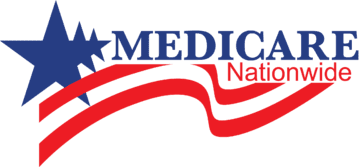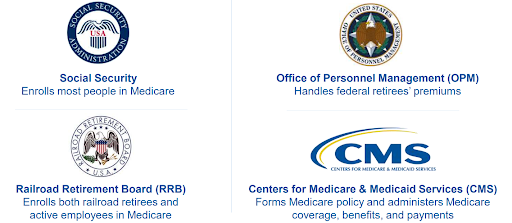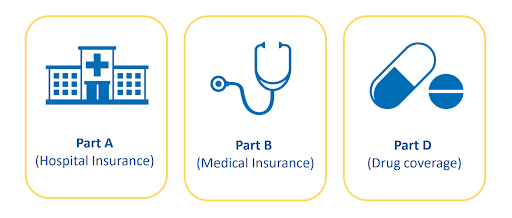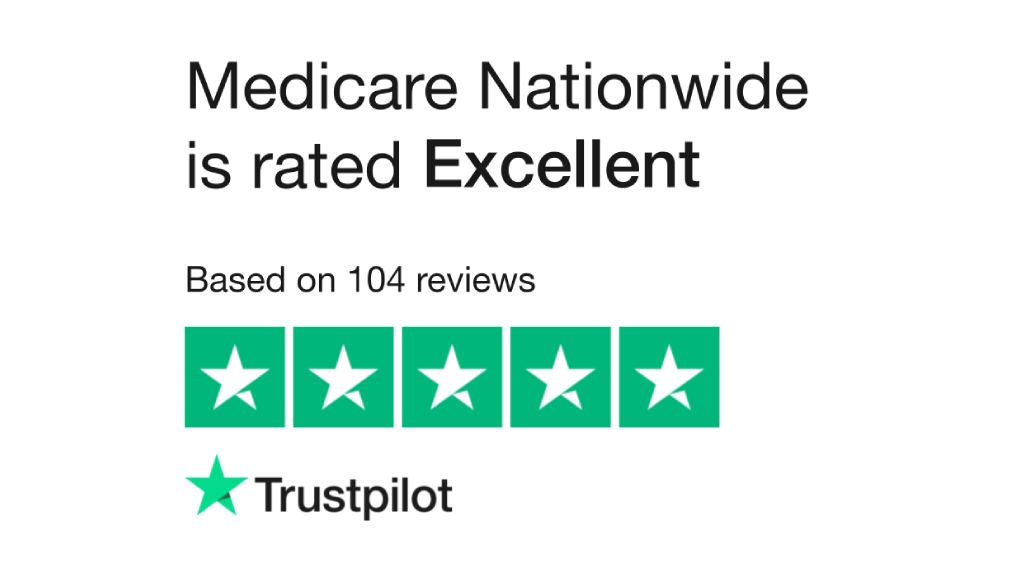What is Medicare?
Medicare, a federal health insurance program provided by the government
Who is Eligible for Medicare?
- People aged 65 or older
- Under-65 individuals with disabilities
- People with End-Stage Renal Disease
Note: Eligibility criteria stipulate U.S. citizenship or lawful presence, along with five years of continuous U.S. residency.
Identifying the Authorities Behind Medicare Administration
- Social Security – Enrolls most people in Medicare
- Office of Personnel Management (OPM) – Handles federal retirees’ premiums
- Railroad Retirement Board (RRB) – Enrolls both railroad retirees and active employees in Medicare
- Centers for Medicare & Medicaid Services (CMS) – Forms Medicare policy and administers Medicare coverage, benefits, and payments
Understanding the Parts of Medicare
- Part A (Hospital Insurance)
- Part B (Medical Insurance)
- Part D (Drug coverage
MEDICARE PARTS
Medicare Part A
Part A, also known as Hospital Insurance, covers various aspects of inpatient care and related services:
- Hospital Care – This includes staying in a hospital, where you’ll have access to a semi-private room, meals, general nursing, prescribed drugs (including methadone for opioid use disorder), and other necessary services and supplies.
- Skilled Nursing Facility Care – Part A also covers inpatient care in a skilled nursing facility (SNF) following a qualifying 3-day inpatient hospital stay.
Additionally, Part A helps with:
- Blood – Coverage for blood transfusions during inpatient stays.
- Hospice Care – Support for end-of-life care and services.
- Home Health Services – Assistance with healthcare services at home.
- Religious Nonmedical Health Care Institution Care – Coverage for inpatient care in religious nonmedical health care institutions.
Premium
Most individuals do not pay a premium for Part A if they or their spouse have paid FICA taxes for at least 10 years. However, there may be penalties for late enrollment if you’re required to buy it, potentially resulting in a 10% increase in the monthly premium and a requirement to pay the higher premium for twice the number of years you could’ve had Part A but didn’t sign up for.
Benefit Periods
Each benefit period starts when you receive inpatient care and ends after being home for 60 consecutive days. You pay a Part A deductible for each benefit period, with no limit to the number of benefit periods you can have, and they can span across different calendar years.
Decision to Enroll
Consider enrolling in Part A as it’s often free for most people. If your work history doesn’t qualify you for premium-free Part A, you can still enroll, but delaying may result in penalties. If you’re actively working and covered by an employer plan, consult your benefits administrator. Additionally, to avoid IRS tax penalties, stop contributing to your Health Savings Account before Medicare starts.
Medicare Part B
Part B, also known as Medical Insurance, covers a range of healthcare services and supplies. Here’s a simplified breakdown:
What Part B Covers:
- Doctor visits
- Outpatient medical and surgical services
- Lab tests
- Durable medical equipment (like walkers)
- Supplies for diabetes testing
- Preventive services (such as flu shots)
- Home health services
- Therapy services, like physical and occupational therapy
- Mental health care
- Limited outpatient prescription drugs under certain conditions
Preventive Services Covered by Part B:
- Screening for various conditions like abdominal aortic aneurysm and colorectal cancer
- Counseling for alcohol misuse and tobacco use prevention
- Vaccinations, including for Covid-19
- Screenings for diseases like HIV and hepatitis
- Regular check-ups like mammograms and flu shots
What’s Not Covered:
- Services like eye exams for eyeglasses or cosmetic surgery
- Long-term care
- Certain therapies like massage therapy
- Routine physical exams
- Hearing aids and related exams
- Some dental care
Decision Considerations for Part B:
Monthly premium payments, typically deducted from Social Security benefits, allow for the option to delay enrollment in Part B if covered by other health insurance through current employment or a spouse’s/family member’s employment, with the ability to apply for Part B during or after employment ends, depending on situations necessitating Part B enrollment.
DISCLAIMER: Please note that enrollment in Part B may be delayed if you currently hold coverage under a group health plan (GHP) through your own employment, your spouse’s employment, or the employment of a family member due to disability. If you wish to defer your Part B coverage, it is essential to decline Part B before your Medicare coverage commences. You have two options to decline Part B:
- Follow the instructions provided with the card and return the card. Failure to return the card indicates your intention to retain Part B coverage and obligates you to pay Part B premiums.
- Contact Social Security at 1-800-772-1213 (TTY 1-800-325-0778) to decline Part B coverage.
In summary, Part B covers a range of essential medical services and preventive care, but it’s important to consider factors like premiums and enrollment timing based on individual circumstances.
When you must have both Part A & Part B:
- To buy a Medicare Supplement Insurance (Medigap) policy.
- To join a Medicare Advantage Plan.
- If you’re eligible for TRICARE for Life (TFL).
- If you’re eligible for the Civilian Health and Medical Program of the Department of Veterans Affairs (CHAMPVA).
- When your employer coverage requires you to have it (if your employer has fewer than 20 employees).
Medicare Part D
Medicare Drug Coverage, also known as Part D, is an optional benefit available to all beneficiaries. It’s managed by private companies that work with Medicare. This coverage includes:
- Medicare drug plans (PDPs) that work with Original Medicare
- Medicare Advantage Plans with drug coverage (MA-PDs)
- Some other Medicare health plans
How Part D Works
Joining a plan is optional, but there might be a penalty for late enrollment; plans feature formularies listing covered drugs that may change throughout the year, with notifications for any updates; opting for a preferred pharmacy can lower out-of-pocket expenses; and if you have limited income and resources, you might qualify for Extra Help.
Medicare Drug Plan Costs in 2024
Most people pay a monthly premium that varies depending on the plan and income, with some plans also featuring a yearly deductible, copayments, or coinsurance for medications, and out-of-pocket costs encompassing a percentage of the expenses during the coverage gap, commencing at $5,030 in 2024, and ceasing any copayment or coinsurance obligations after reaching $8,000 in out-of-pocket expenses.
Consider Costs, Coverage, and Possible Penalties
- If you have existing drug coverage, evaluate whether joining a Medicare drug plan will affect your health coverage and how your out-of-pocket costs compare.
- If you don’t have existing coverage, think about whether joining when you’re first eligible will help you avoid penalties later. Additionally, check if you qualify for Extra Help to join a plan without penalty.
Common Aspects of Medicare
Enrollment
Initial enrollment typically occurs around the time an individual turns 65, with specific enrollment periods for each part of Medicare. There are also annual enrollment periods during which beneficiaries can make changes to their coverage.
Costs
While Part A is usually premium-free for those who have worked and paid Medicare taxes for a certain period, Parts B, C, and D may have premiums, deductibles, and copayments or coinsurance.
Supplemental Coverage
Some individuals choose to purchase supplemental insurance, known as Medigap, to help cover costs that Medicare doesn’t, such as deductibles, copayments, and healthcare services when traveling outside the United States.
Provider Network
Beneficiaries can typically choose any doctor or hospital that accepts Medicare, although some Medicare Advantage plans may have a specific network of providers.
Preventive Services
It covers a range of preventive services, including screenings for various conditions like cancer, cardiovascular disease, and diabetes, as well as vaccinations.
Changes and Updates
Their policies and coverage can change from year to year, so it’s important for beneficiaries to review their coverage annually during the open enrollment period to ensure it still meets their needs.
Government Oversight
The Centers for Medicare & Medicaid Services (CMS) administers the Medicare program, overseeing regulations, payments to healthcare providers, and quality improvement initiatives.
In Summary
In conclusion, Medicare is a federal health insurance program provided by the government primarily for individuals aged 65 or older, those with disabilities, and those with End-Stage Renal Disease. It consists of various parts administered by different authorities, including Social Security, the Office of Personnel Management, and the Centers for Medicare & Medicaid Services.
Understanding the parts of Medicare, such as Part A, Part B, and Part D, is crucial for making informed decisions about coverage options. Beneficiaries can choose between Original Medicare and Medicare Advantage, each offering different benefits and considerations.
Additionally, factors like enrollment periods, costs, supplemental coverage options like Medigap, provider networks, preventive services, and government oversight play essential roles in navigating the Medicare landscape effectively. Regular review of coverage during open enrollment periods ensures alignment with individual healthcare needs.
DISCLAIMER: Please verify the information provided here with the primary source to ensure accuracy. We strive to present information correctly. It is advisable to confirm details directly from the primary source for accuracy and reliability.



